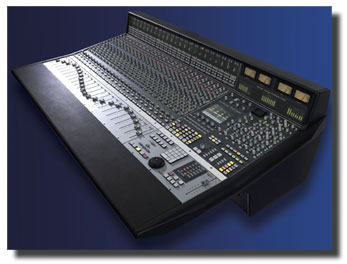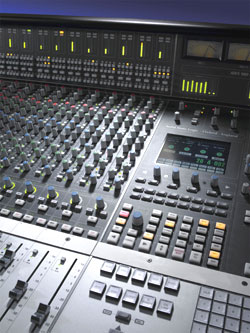
Solid State Logic AWS 900 Analog Workstation System
Reviewed in August 2004 by Mel Lambert
Digital audio
workstations are a remarkable advance.. sometimes. If your model lacks a
decent analog front end, or a properly implemented multichannel monitor section,
or a full-function autolocator/transport controller, more than likely your
workplace is gonna be.. ahem.. cluttered. But riding to the rescue, as in
all good Westerns, comes Solid State Logic with a very nicely implemented
analog/digital hybrid system that will go a long way to solving most if not all
of your problems. And all at a bargain $87k price.
In essence, SSL has taken 24 channels of its fine-sounding XL9000
K-Series SuperAnalogue pre-amplifiers, EQ and channel elements and mated them to
a very clever logic system that makes use of standard HUI command protocols. So,
if your DAW follows these edit/mix/plug-in/transport commands - and most do -
it's just a matter of hooking up the relevant MIDI connects, plugging in
mic/line inputs to the AWS 900, outputs and returns to the workstation, monitor
connects to your 5.1-channel monitor array, and we're off to the races.
Everything you'll need to run a tracking, overdub and remix session is right in
front of you, within easy reach of the sweet-spot mix location; no separate
controllers for the DAW. Nor a batch of outboards hidden under the console, nor
fader trays parked adjacent to an analog mixer. It's all there in the AWS 900,
ready for action.
All I/O signal routing, monitoring and signal processing control is
permanently available on the AWS console. SSL's SuperAnalogue technology is
designed to offer bandwidth in excess of 192 kHz, while 24 channels of ultra
low-noise dual impedance mic pre-amps match those of the new XL Series - sweet
and very smooth sounding. EQ is magic: a choice of switchable twin-curve E
Series or G Series four-band parametrics, plus an assignable array of SSL
dynamics sections offering gate, expander and compressor/limiting. Also offered
is the very useful G Series compressor across the stereo mix buss. Motorized
faders provide not only conventional audio control but also control
record/replay levels within the attached DAW. Metering is provided on all
channels and main outputs - the latter with precision VUs just like a
top-of-the-line SSL console.
The right-hand DAW control section is festooned with useful
features, including transport controls, autolocator, programmable buttons for
custom functions and everything you need under your fingers. Usefully, SSL has
included dedicated buttons for the Alt, Option, Shift and Control keys we need
for contextual controls that litter command menus for such DAWs as Pro Tools,
Logic and Nuendo, plus duplicate keyboard ESCAPE, UNDO, SAVE and ENTER buttons -
saves reaching for the ASCII keyboard and/or mouse.
Time and time again, I was left with the distinct feeling that
somebody at SSL's Begbroke HQ not only spends a lot of time with DAWs, but
understands that modifier keys are the magic ingredient when speed in money, and
we have refined our chops over long hours of editing and mixing sessions. The
adjective I kept returning to time and again was "Integrated" -this beast packs
a lot of power in a small package, and oozes with ergonomic thinking.
In terms of signal topology, during tracking, overdubs and remix
the 24 analog and/or playback signal paths pass through a dual mix-buss design
that provides full control of input sources and DAW tracks for mixing and
separate assignment to 5.1, stereo or stereo down-mix monitor outputs. For added
flexibility, EQ, assignable dynamics and insert ports can be set up in any order
within the signal path. An array of eight dedicated track busses route
pre/post-fader signals to DAW tracks. Two main busses handle Record and Mix
assignments, while effects and cue/foldback sends - in stereo and mono modes -
are available from all 24 channel modules, matched by four stereo effects
returns. A bevy of solo modes include a very useful Solo in Front. Channel
meters are complemented by a quartet of VU meters for the L/R Record and Mix,
plus eight Buss Outputs.
Mimicking an in-line design, the assignable rotary control and
level fader on each channel strip can be swapped to adjust analog level and/or
DAW levels; the assignable control can also be set to other functions, as
necessary. While controlling playback/mix levels within the companion DAW, the
24 available faders can be bank switched to control other tracks, as necessary.
(And, oh yes, all 24 faders can be swapped to control a bank of aux levels for
setting up those devilishly intricate effects-send mixes.). Console metering can
also be switched to display input or DAW metering, while a central TFT color
display shows DAW status and plug-in settings, plus a variety of console data.
The workstation control section provides direct access to all major
DAW mixing, editing and automation parameters, plus plug-in settings. Setting
parameters are displayed on a color TFT display surrounded by dedicated control
keys. Master and individual buttons per channel switch the fader element to
either the analog console layer or the DAW control layer.
A bank of four rotary encoders with companion pushbuttons and
assign keys - plus page up/down keys - control the DAW's plug-ins and DSP
functions. More controls would be nice - current reverb plug-ins, for example,
feature a high parameter count - but this quartet lets you get where you are
going quickly and easily. Automation, grouping, editing and function-key
selection is handled via a bank of 16 soft keys. Usefully, DAW faders can be
bank swapped in groups of 24, to bring the key channel closer to the central
sweet spot.
For controlling the myriad workstation functions, one option might
be to incorporate an array of assignable buttons and knobs, all of which take up
acres of real estate and need the reach of an octopus. SSL has obviously spent
some money on ergonomic textbooks, because the AWS solution is elegant yet
purposeful. All functions are a button push away, and map to a central array of
well-labeled controls. Sure you might benefit from more controls, but at what
cost of mind numbing complexity? For my money at least, I could live with the
AWS 900's solution; it puts power in front of you but not at the expense of
unnecessary confusion.
The built-in logic switching enables some neat tricks. The two
stereo Cue Sends and four Mono FX Sends can be used for other purposes via the
EFX re-assign section, which thence serves as a source for the eight busses or
the channel Direct Output. In this way, Cue/FX Sends can be set to route to a
pair of independent foldback sections that enable creation, for example, of a
zero-latency headphone output. Two separate foldback mixers can be set up with
level control, cut and AFL, and sourced from Cue STA, Cue STB, Record, Mix,
external source or control room monitors. The quartet of Stereo Returns feature
Level, Cut, AFL and discrete routing to foldback outputs, plus direct access to
Record and Mix busses with Pan and Width Controls. So much from so little!
 Within the Master Panel (pictured right) either of the two main stereo
busses can be assigned to the master fader, and a stereo compressor inserted as
necessary. Compression controls match those of a G-Series console, and add a
continuously variable threshold and make-up. A handy Insert Sum enables
sub-mixing via the stereo bus insert to the main busses; +10 dB of useful boost
can also be added to either buss. Solo modes include latching destructive,
Stereo AFL, mono PFL, inter-canceling ALT, Fleet and non-latching. A neat
Solo-in-front option provides a mix of LR with the selected AFL signal.
Within the Master Panel (pictured right) either of the two main stereo
busses can be assigned to the master fader, and a stereo compressor inserted as
necessary. Compression controls match those of a G-Series console, and add a
continuously variable threshold and make-up. A handy Insert Sum enables
sub-mixing via the stereo bus insert to the main busses; +10 dB of useful boost
can also be added to either buss. Solo modes include latching destructive,
Stereo AFL, mono PFL, inter-canceling ALT, Fleet and non-latching. A neat
Solo-in-front option provides a mix of LR with the selected AFL signal.
In terms of monitoring various signals from the analog input of DAW
replay section - or combinations - the AWS 900 really shines. Two independent
5.1 mains plus two stereo "mini" outputs are available, and can be fed from the
Stereo Downmix Summing Matrix, with independent bass/LFE management. An external
source selector sums, assigns and routes up to four 5.1 sources, with source
selection to control room, studio LS and headphone feeds. Monitor sources
include Record and Mix Busses, Track Busses, four 5.1 sources and four stereo
sources. Whew!
MIDI implementation seems to have been made correctly, with full
Mackie HUI compatibility and fast data throughput; a MIDI IN/OUT pair is used
for each group of eight DAW channels, which dedicates the full bandwidth of a
16-channel MIDI interface to carry AWS control and status data to/from the
workstation. I discovered that under Pro Tools V6.4, for example, 42 dB of gain
control is mapped to 80% of the channel fader scale, compared to more than 50 dB
on a normal analog console fader. In fact, the expanded DAW fader scale
maintains better than 0.2 dB of resolution in the main working area, with a
smooth taper outside that region. Although the analog section is currently
non-automated, under DAW control SSL has pulled a few extra tricks that enable
the plain-vanilla automation of Pro Tools, for example, to be extended to offer
a bunch of additional modes; after all, SSL knows about console automation!
[STOP PRESS: A Total Recall upgrade package that scans all analog faders, pots
and switches, and stores settings on the host DAW as MIDI data for manual reset,
will be available for the AWS 900 by late 2004; price $4,495.]
My reservations are pretty minor. I can live with 24 analog signal
paths - sufficient for most tracking sessions involving a basic rhythm section,
vocal and instrumental guide tracks - but would liked to have seen more
on-surface faders for DAW control. Given that the bank switching is very fast
and intuitive, I can live with the compromise. I would also like to have seen
the control section in the physical center of the console, between 12 channels
east and west, but it's not much of a reach to the right-hand area. The color
scheme is okay, but it's sometimes hard to see the legends under dim lighting
levels. Some orange or bright green colors might have been used, rather than the
familiar, but low-contrast, SSL grays and white, yet it's surprising how soon
you learn the uncluttered surface features.
All in all, even a few minutes on the AWS 900 Analog Workstation
System convinces you that there are two types of DAW users. There are users who
haven't experienced this miracle - and who blunder along with major compromises
- and those that have seen the light. Knowledge is power.
My sincere thanks to Matt Derbyshire, product executive, and Phil
Wagner, senior VP of SSL's Hollywood office, for providing access to the new AWS
900 Analog Workstation System. Check it out at
SSL regional offices and
GC Pro
outlets.
![]()
©2023 Media&Marketing. All Rights Reserved. Last revised: 02.20.23